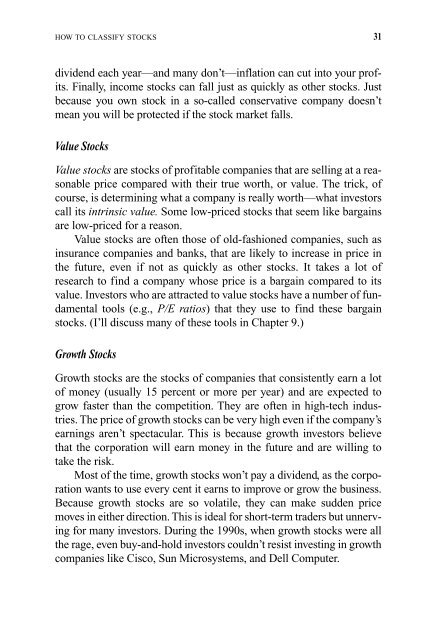Understanding Stocks
Understanding Stocks
Understanding Stocks
Create successful ePaper yourself
Turn your PDF publications into a flip-book with our unique Google optimized e-Paper software.
HOW TO CLASSIFY STOCKS 31<br />
dividend each year—and many don’t—inflation can cut into your profits.<br />
Finally, income stocks can fall just as quickly as other stocks. Just<br />
because you own stock in a so-called conservative company doesn’t<br />
mean you will be protected if the stock market falls.<br />
Value <strong>Stocks</strong><br />
Value stocks are stocks of profitable companies that are selling at a reasonable<br />
price compared with their true worth, or value. The trick, of<br />
course, is determining what a company is really worth—what investors<br />
call its intrinsic value. Some low-priced stocks that seem like bargains<br />
are low-priced for a reason.<br />
Value stocks are often those of old-fashioned companies, such as<br />
insurance companies and banks, that are likely to increase in price in<br />
the future, even if not as quickly as other stocks. It takes a lot of<br />
research to find a company whose price is a bargain compared to its<br />
value. Investors who are attracted to value stocks have a number of fundamental<br />
tools (e.g., P/E ratios) that they use to find these bargain<br />
stocks. (I’ll discuss many of these tools in Chapter 9.)<br />
Growth <strong>Stocks</strong><br />
Growth stocks are the stocks of companies that consistently earn a lot<br />
of money (usually 15 percent or more per year) and are expected to<br />
grow faster than the competition. They are often in high-tech industries.<br />
The price of growth stocks can be very high even if the company’s<br />
earnings aren’t spectacular. This is because growth investors believe<br />
that the corporation will earn money in the future and are willing to<br />
take the risk.<br />
Most of the time, growth stocks won’t pay a dividend, as the corporation<br />
wants to use every cent it earns to improve or grow the business.<br />
Because growth stocks are so volatile, they can make sudden price<br />
moves in either direction. This is ideal for short-term traders but unnerving<br />
for many investors. During the 1990s, when growth stocks were all<br />
the rage, even buy-and-hold investors couldn’t resist investing in growth<br />
companies like Cisco, Sun Microsystems, and Dell Computer.

















